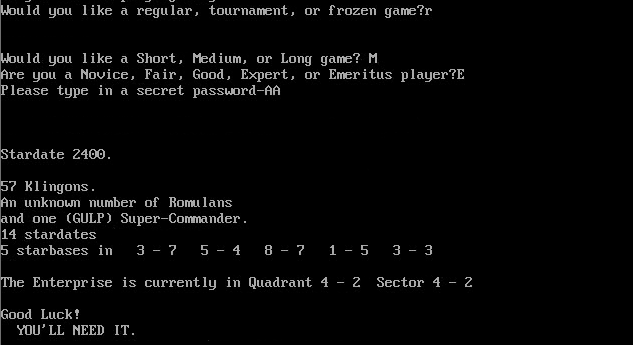
In this blog’s first entry, I briefly discussed some candidates for the title of very first computer wargame. I mentioned Civil War (1968) and the various games called Empire, but I forgot a stronger contender : Star Trek.
I planned to cover Star Trek eventually, but it did not fit in my initial definition of wargames so I felt like I should start with purer examples of the genre and go back to it later. As I reviewed more games, especially space games, I realized how influential Star Trek was, so it is high time I cover it.
The history of Star Trek the video game as been covered better than I ever could in other places, in particular by the Digital Antiquarian but also by gameoffame, which managed to collect the testimonies of the first developers. Here is the short version : starting in 1971, Mike Mayfield programmed the game on a mainframe computer (a Sigma 7), and then he programmed it again in BASIC on a HP2000C, finishing in October 1972. This BASIC version was added to the HP public program library. There the program was spotted by David Ahl and Mary Cole, who modified the code further before republishing it in the 1973 edition of 101 BASIC Computer Games.
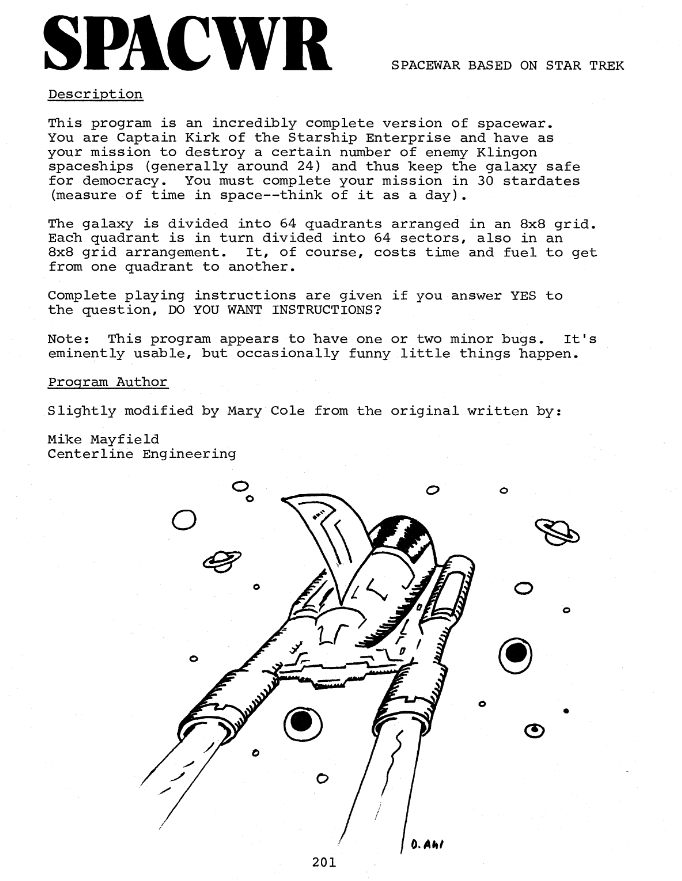
Thus began a process in which the code of the game was copied, modified and republished ad infinitum. There were quickly a myriad of versions, many of them having their own sub-branches. Most faded to obscurity.
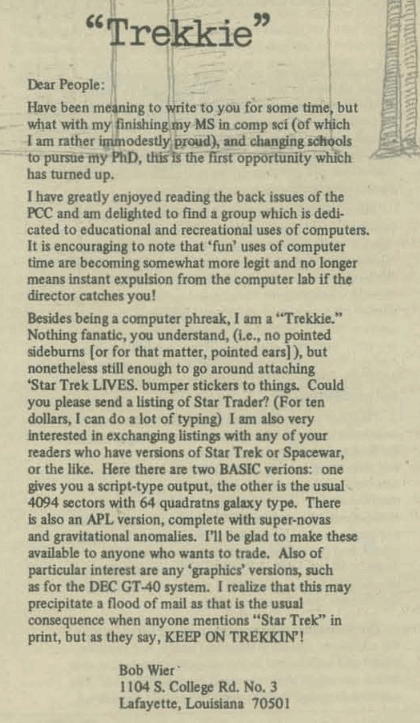
Most, but not all. In September 1974, Robert Leedom proposed his own version in the People’s Computer Company newsletter. David Ahl, who had at that point launched Creative Computing, took notice and reached out to Leedom. In June 1975, Ahl would publish the code for “super STAR TREK” in Creative Computing and, absolutely critically, publish it again in the second 1978 edition of 101 BASIC Computer Games.
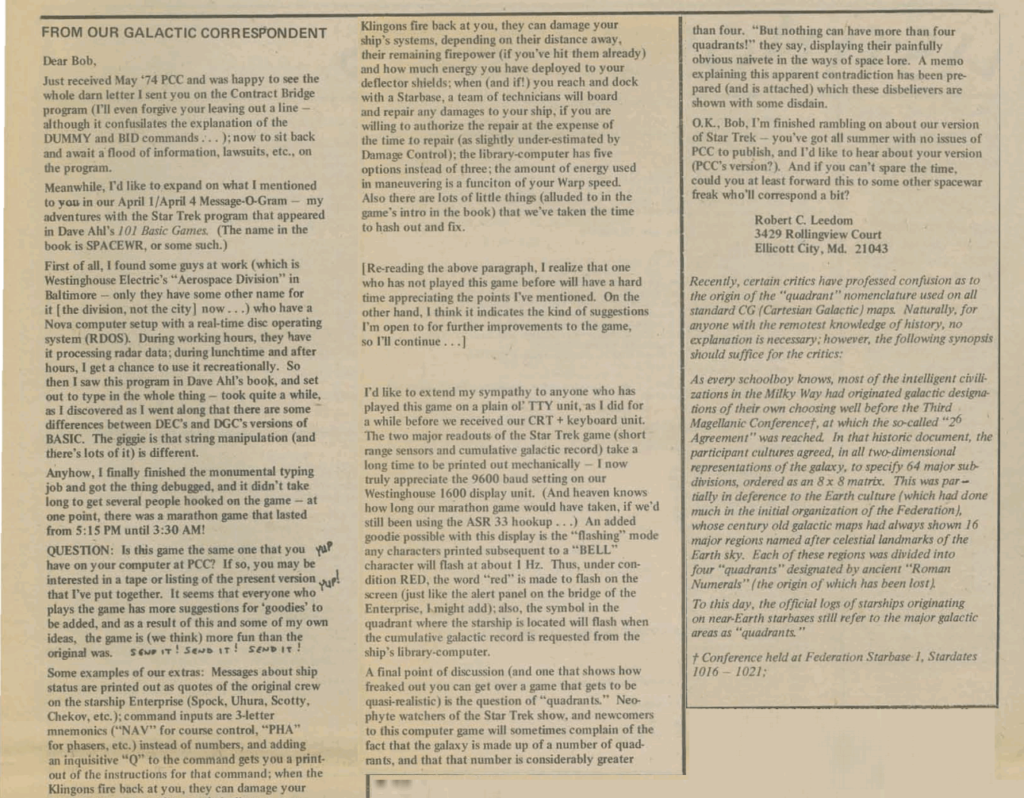
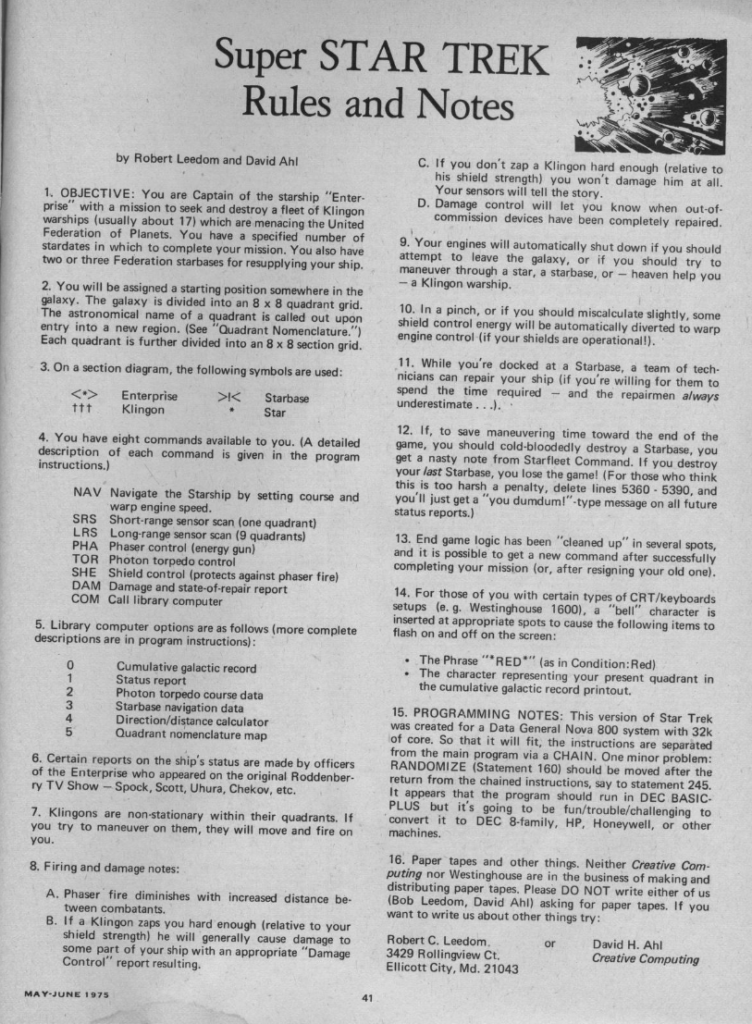
This was a turning point. With Creative Computing in 1976, Super STAR TREK (which I will write Super Star Trek from now on) became a great version among many. But 101 BASIC Computer Games sold more than one million copies starting in 1978- enough to enforce a new standard. The not-Super Star Trek branch would carry on, but most versions from that point onward would be derived from the Super Star Trek version.
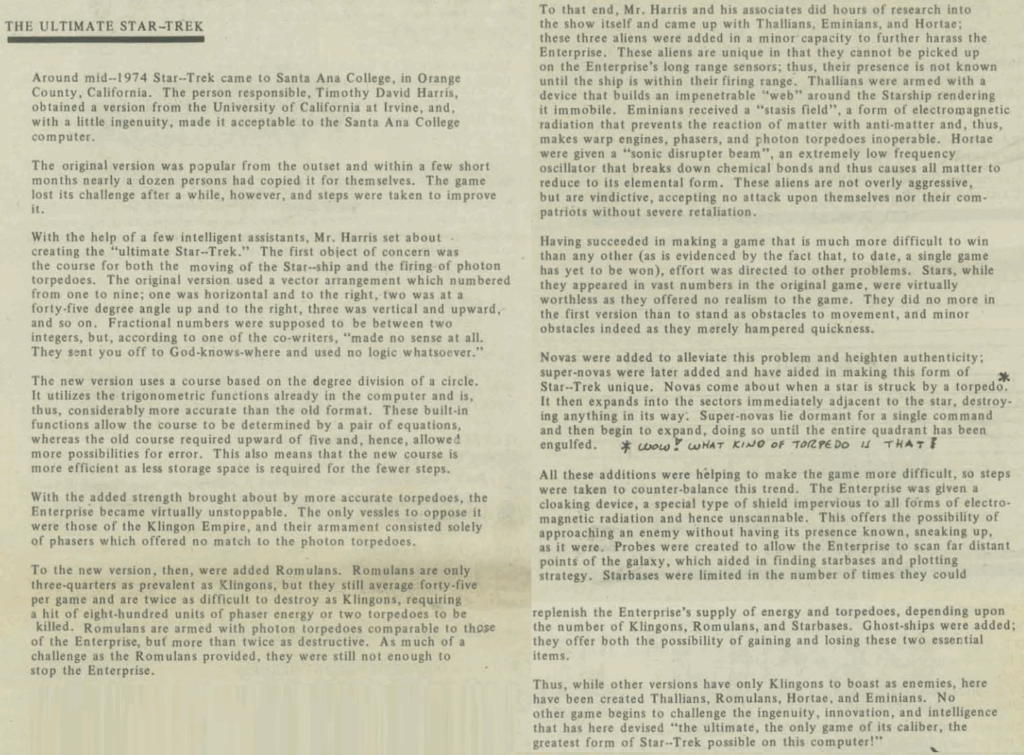
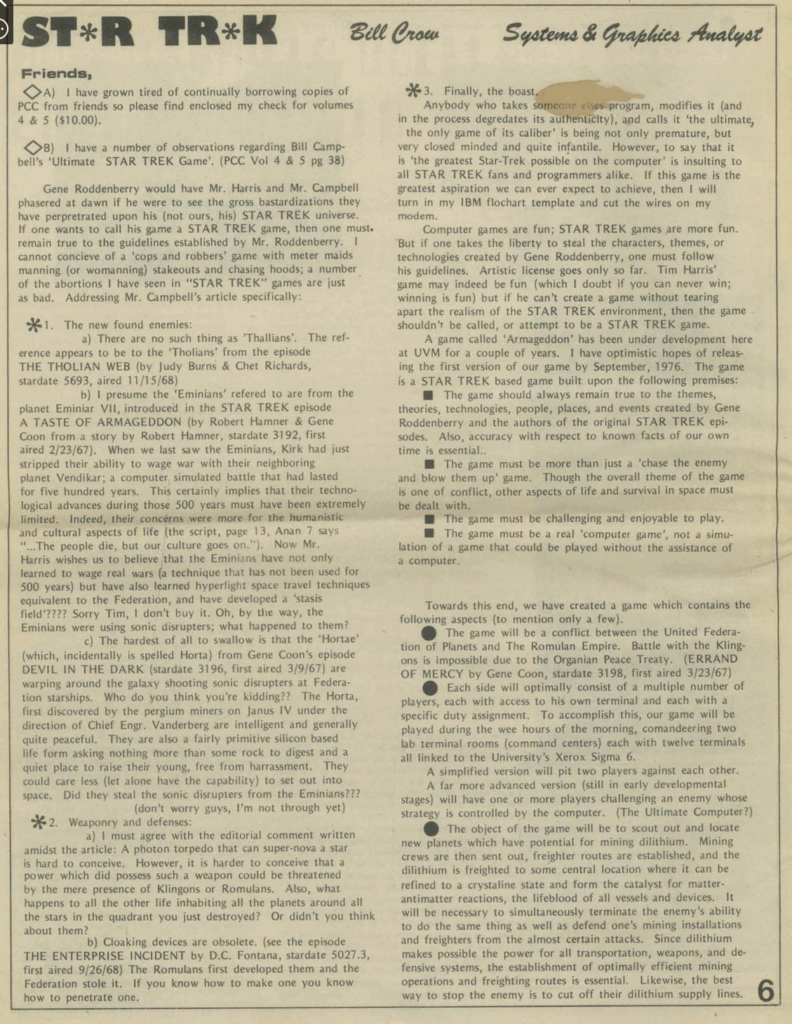
Ultimately, every new computer and/or coding language would have at least one and usually several versions of Star Trek, with its own variations compared to earlier versions, sometimes due to the limitation of whatever platform they are made for, but more often stemming from the creativity of the developers. This is still true today, though of course the game’s popularity waned starting in the mid 80s. There are most probably more than one hundred versions of the game : this site lists about 50 of them, but I found many that were not listed (for instance, I found between 3 and 5 versions for the TRS-80 alone).
This leaves the question of which version I am going to play. I could have played the original Mayfield or Ahl/Cole, but decided against it : it has been done already by the Data Driven Gamer and I wouldn’t have much to add. Plus, I don’t strive to necessarily play the earliest version of every game. Leedom’s Super Star Trek was a stronger contender, but I couldn’t initially find it. Then I discovered Stu managed to extract the code directly from 101 Basic Computer Games and played it on Twitch/Youtube, so it is covered as well.
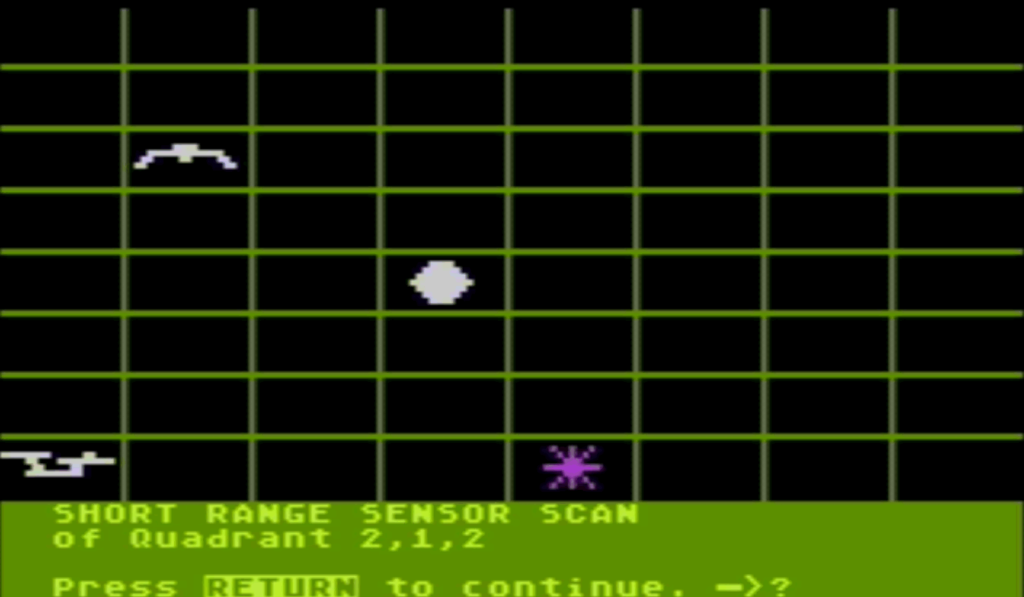
I decided to play one of the DOS versions of Super Star Trek. This version was supposedly coded by David Matuszek and Paul Reynolds in 1982, and then resurrected and improved (bugfixes, and a few features I will not use) by Don Smith and Tom Almy in 2014. Checking screenshots attributed to the not-improved 1982 version and what I see in my game, they actually look nothing alike ; but then I cannot rule out that the screenshots attributed to the 1982 version are incorrect – such is the magic of Star Trek. In any case, it is a Super Star Trek game, so it will do.
This was my initial situation :
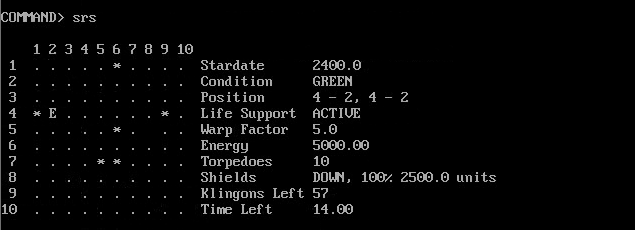
The USS Enterprise (“E”) started in an empty quadrant, except for 6 stars (*) which are simply obstacles. I must destroy every single one of the 57 Klingon ships in the galaxy (including Commander ships and one super-Commander ship). With that number they would conquer the universe in 14 time units, but the more ships I destroy, the longer it will take them.
Given there was nothing in this quadrant, I activated my long-range sensors :

The long-range sensor told me what I could find in the 8 quadrants around me. Information is conveyed by numbers. For each quadrant :
- the last digit is the number of stars (useless to know),
- the second digit is the number of starbases,
- the first digit is the number of Klingon ships.
There was a large number of Klingons on my left, so that’s where I headed next :
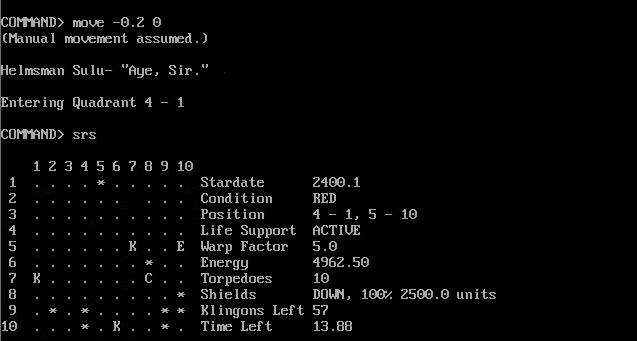
Three regular Klingon ships (K) and one Klingon Commander ship (C). My shield was down so I had to destroy them all quickly. For this, I decided to use my phaser.
This version of Star Trek tells you how much energy you must spend for a sure kill. You can allocate less of course, if you like to live dangerously.
In this case, my shield was down (which allowed my phaser to be more efficient), the Klingons were not too far from my ship (phaser efficiency decreases with distance), I was almost at full energy and there was a starbase not too far away to refuel, so I had no reason to take risks.
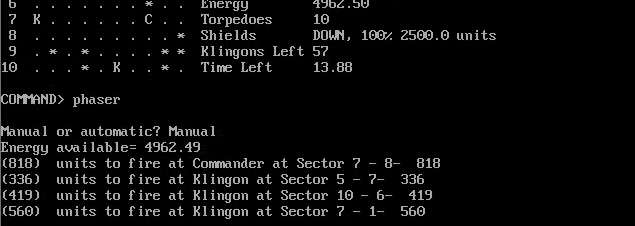
And since I took no risks, I destroyed them all :

As I was preparing to jump to another system, I had a surprise :

I was tracted to quadrant 3-7 (something only commanders and Super-Commanders can do). But it could not be the Super-Commander, because it was currently in quadrant 7-4 blowing up planets. The Super-Commander is the only Klingon ship that is moving on the galaxy map, blowing up stuff that could be useful to you (including starbases !).
I got lucky though : I got pulled by a lone Commander into a quadrant with a starbase :
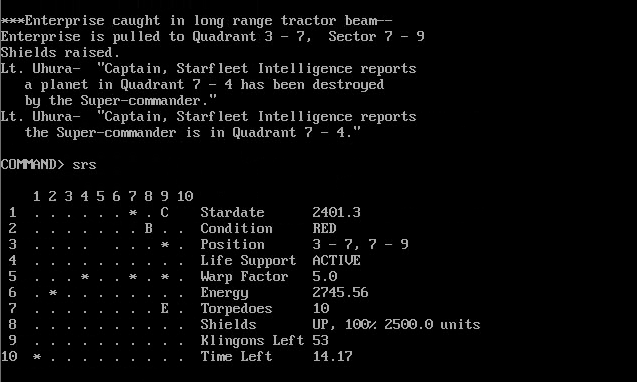
As you can imagine, that Commander did not last long, and I could directly refuel at the base. Thanks for the ride !

Full energy again, 5 Klingon ships down, and I had more time than I started with.
Assessing the situation by a long-range scan, and then checking the galaxy map :
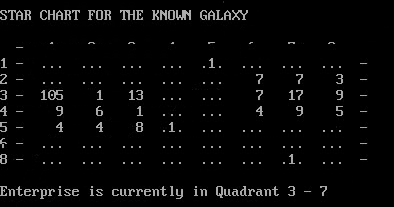
I was on the other side of the galaxy. That was some powerful tractor they used. A good thing they did not try to pull and destroy starba…
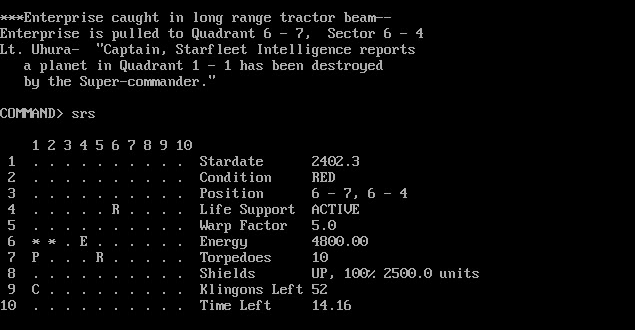
AGAIN ?
Well, here I was faced with one Klingon Commander, two Romulans (R), and there was also a planet (P).
Romulans can be pretty dangerous opponents. They are not displayed on the map, and they don’t attack you if you are in a Federation quadrant (=there is starbase) or if they are alone in a quadrant and you are just passing. But here, they were working with the Klingons.
In any case, I was at full energy again, and therefore :
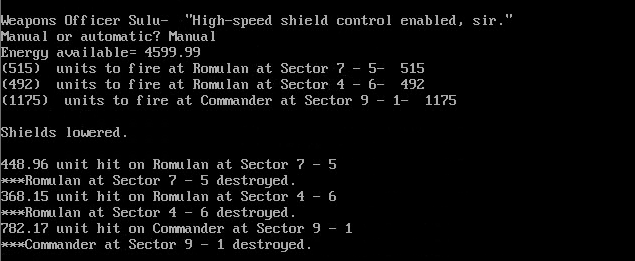
I scanned the planet and interestingly it had dilithium crystals. As in a real Star Trek episode, I shuttled down with my crew, Uhura, Spock and Ensign Riley (shuttles are safer than teleportation beams) :
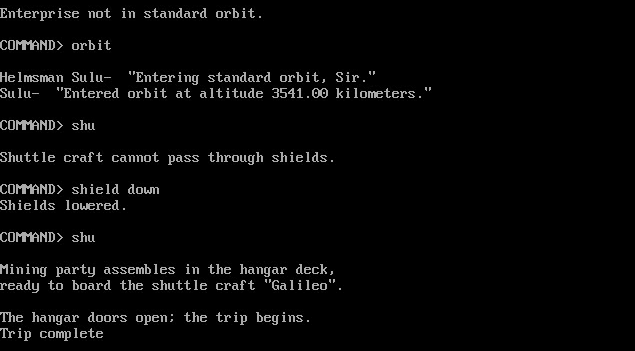
Then I took some risks, and loaded my ship with the dilithium crystals. This was a tense moment… but it worked !
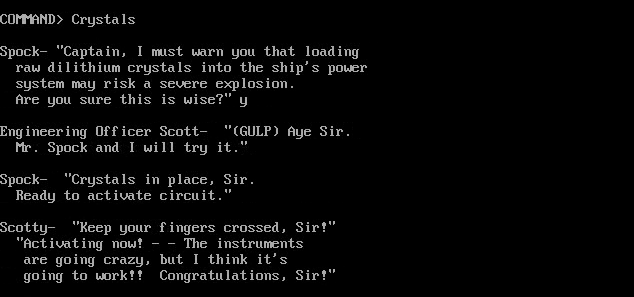
And with that, my ship was at close to 9 000 energy !
At this point you get the gist of it – with 9 000 energy I could move from system to system raining punishment down on the Klingons. I will just cover a few outstanding events.
After dispatching a high number of Klingons, I beelined for one of my starbases to refuel and repair (my phaser had been damaged by overheating as I had shot too many Klingons at the same time). Alas, there was a commander ship blockading the starbase.
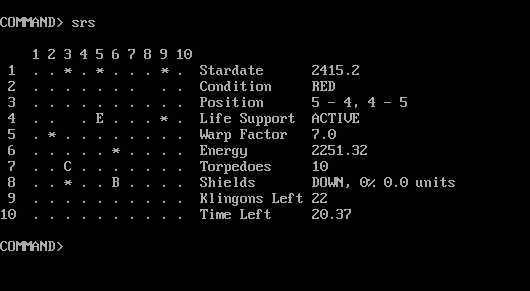
As you can see, my energy was very low. I even needed to drain down my shield’s energy to reconstitute my reserve somehow. I was therefore very vulnerable, and as I said without phaser.
Well, no biggie, I am going to use two photon torpedoes. That should do the trick, and I still have my maximum allotment of 10.
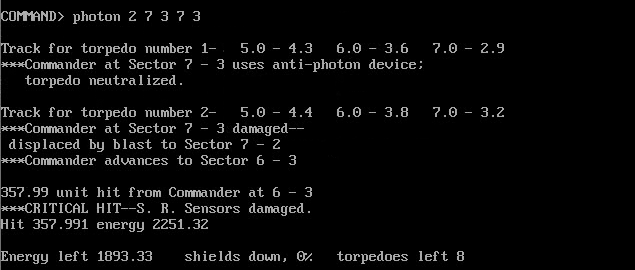
Darn ! The commander neutralized one of the torpedoes, and it survived the other. And then it shot back and destroyed my sensor. I was blind :
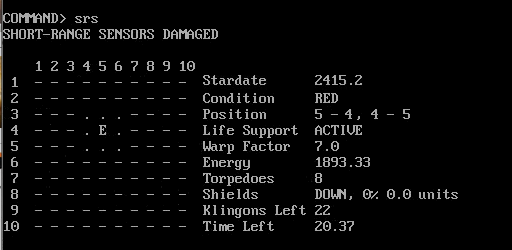
But as the Commander had moved, I had been informed of his last coordinates (6-3) so I sent a torpedo to that location !

The only thing left to do was to limp back to the starbase :
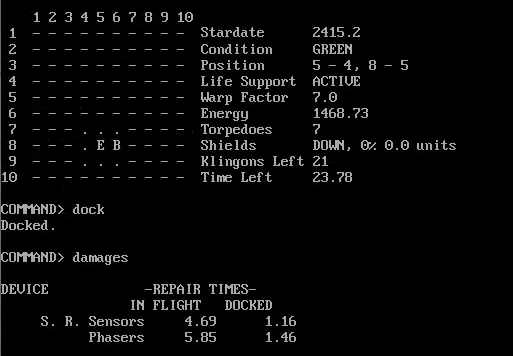
I just had to wait 1.46 time units, and I was ready to finish the 21 Klingons left.
A bit later – and at this point it was mostly mop-up, I jumped into a system with a rare surprise :

A lone standard Klingon. Trivial. That T was more worrying though – those are Tholian spiders !
It started to weave its web around the quadrant as I dispatched the Klingon.
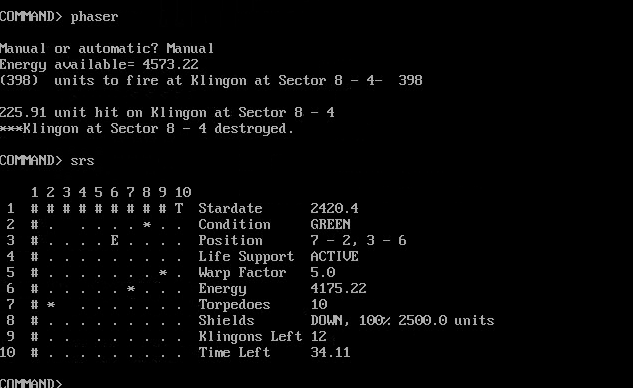
I tried to escape to the right, but too late !
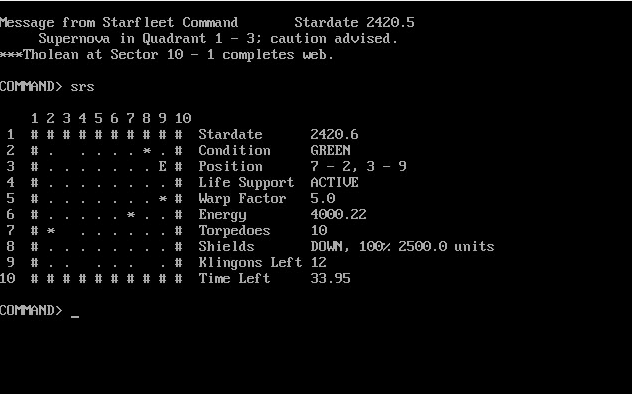
I was blocked. I tried to use my phaser and torpedoes to break the web, to no avail. Well, maybe with enough speed I could breach through.
At any point in the game, you can change your Warp Factor. The higher the Warp Factor, the faster you travel (often allowing you to move tactically without the enemy being able to shoot back at you). Warp Factor 7 is the highest safe speed. But this was not the time to play it “safe”. If those webs could be pierced, I would have to go at speed Warp Factor 10.
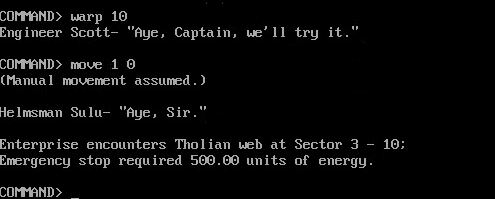
Failed !
I had only one option left. Ask the starbase to beam my whole ship home. An extremely risky procedure : dematerializing the USS Enterprise is easy. Rematerializing is, well, not as easy. Due to my distance to the closest starbase. I had less than 50% chance of making it through :
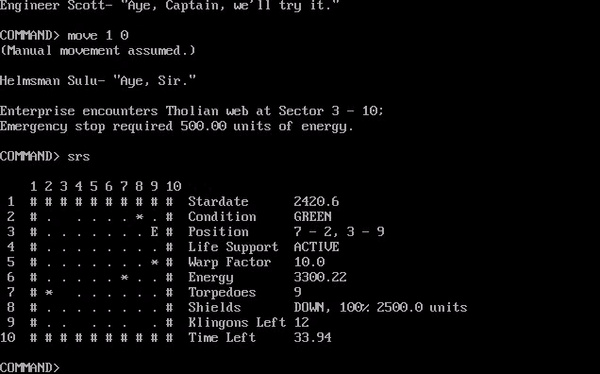
This had been a close call, but the Captain and his crew made it through.
I forgot to slow down, and my Warp Factor 10.0 made the spacetime continuum mumbo jumbo unstable… I went back in time.

After that, I throttled down to a more reasonable Warp Factor 5.0.
Defeating the remaining Klingon ships, I had only one last target : the super-Commander.
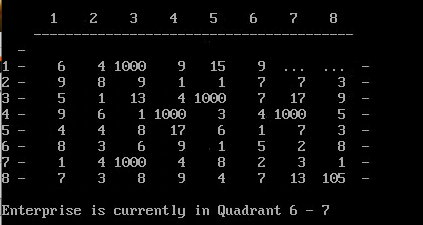
It was in quadrant 8-8 at this point, but every time I jumped to its quadrant it moved to another. I had to push my Warp Factor up to 6.0 to catch it :

As I was almost at full energy and full shield, the Super-Commander did not stand a chance :

Victory for the Federation :

Rating and Review
Star Trek by Mike Mayfield, and then a lot of people.
First release : 1973 on Hewlett-Packard computers
Tested on : Various, DosBox for the 1982 DOS Super Star Trek version
Total Hours Tested : 6 hours (including 3 hours for the 1982 DOS Super Star Trek version)
Average duration of a battle : 30 minutes
Difficulty: Average (2/5)
Would recommend to a modern player : Maybe. It is simple but fun.
Would recommend to a designer : Yes
Final Rating: 33/100
Except when specifically mentioned, my review only applies to the 1982 DOS version of Super Star Trek version.
A. Immersion
There is a reason why Star Trek in general, and Super Star Trek in particular was so influential. The game may have only ASCII graphics, but it is immersive. The vocabulary, the quips from the crew, the moments of tension when you use crystals, call for help or try experimental weapons, and more generally the whole exploration of dozens of quadrants, never being sure what you will find inside – it just feels Star Trek. It just works beyond what I can explain.
And I am not even a Trekkie.
Score : 7/20 – probably more like 11/20 if you are a Trekkie.
B. Systems
The game really is all about energy management. Energy is everything : fuel to travel, ammo for the phasers, shield, and health points. The only other numbers the player has to manage are time and the number of photon torpedoes.
Therefore, the game is essentially an energy management game :
- The player can move fast (high Warp Factor) but this is extremely consuming in energy, or they can move slowly and risk running out of time.
- The player can have their shield up to avoid critical damage, but at the cost of more expensive movement (in energy !) and move expensive shots (in energy !), or they can run around shield down and risk losing everything if on the receiving end of a critical hit,
- The player can use their phaser at a level where they are sure to kill, but when there are 6 or more Klingons in a quadrant, this will drain most of the energy in one combat (and the phaser can overheat). Or they can use low-energy phasers, or get closer to the enemy first, or use photon torpedoes,
Starbases fully recharge your energy (7500 in total, including 2500 to the shield), so in theory it should be easy to clean up the quadrants one after the other with maximum firepower, and then come back. In practice, at the beginning of the game, things are never going as well as expected, with the Super-Commander blowing up planets and sometimes, rarely, starbases and the regular Commanders tracting you left and right before you get a chance to recharge.
After this, the game is easy, and except at the very beginning you will more often die what NetHack/Rogue players would call a YASD (“Yet Another Stupid Death“) : moving straight into a black hole, experimenting with a crystal or a super weapon when clearly you could use anything else, forgetting your speed is Warp Factor 1.0 and running out of time, … If you play carefully : jump in, phase everyone, jump out – you should be super safe.
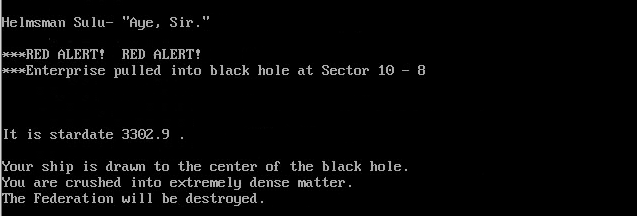
In a nutshell, when things are going well, the game is not that interesting, but it goes fast. And just like a roguelike, the game gets actually fun when things are going awry. This is another reason for which this game was so popular.
Score : 4/20
C. UI , Clarity of rules and outcomes
The game uses keyboard commands for everything, but it accepts several commands for the same effect (short-range scan can be written “srscan”, “srs” or “s”).
This version of Super Star Trek‘s UI is a bit different to the norm, in that it does not use numpad for movement (0 for left, 2 for down, 4 for right …) but asks you to input X and Y coordinates, either in absolute or relative to your ship. I find this easier to use.
Not much to say, mostly because it is efficient and does not get in the way.
Score : 10/20
D. Scenario design & Balancing
There are a few options on the version I am using, but I don’t feel they change much except the number of Klingons to blast. The game puts you in interesting situations from time to time, but as I stated earlier, it is mostly hard at the beginning, and easy afterwards if you don’t go gung-ho.
AI is not great and feels pretty mechanical. Commanders tract you to their location at random times, instead of doing it when you are weak. The Super-Commander randomly blows stuff up, instead of beelining for the starbase. Even in combat, the Klingons don’t do much except get as close to you as possible and shoot at you.
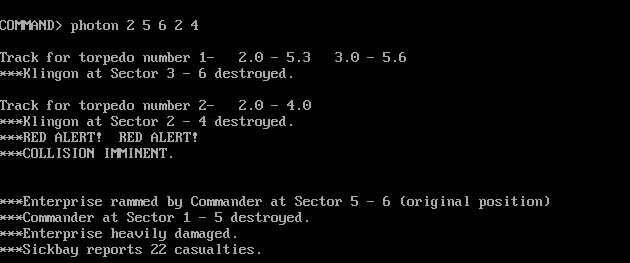
Score : 5/20
E. Fun and replayability
I am surprised that I actually liked the game a lot. This does not come from the game rules, but rather from how naturally it flows. The game is easy, certainly, but you are never more than three keyboard commands away from action. I could see myself launching this game to kill time.
I feel like I have seen everything there is to see at this point – for this version anyway. Still, the game kept my interest for several hours, not bad for a game conceived 50 years ago whose original code could be fully contained in a few pages.
Score : 7/20
F. Final rating
Score : 33/100. Star Trek has had staying power for decades for a reason. In addition, it is a genre of game that is not made better by just adding better graphics, hence why so many years later it still performs so well.
As far as future Star Trek games are concerned : I will not play them… in general. Some are particularly notable for doing something different (I have in mind Star Fleet I), and I may cover these.